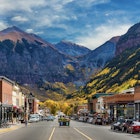
See Mars disappear behind the moon in a lunar occultation
Feb 17, 2020 • 2 min read

Mars with Earth visible in the background © World Perspectives/Getty Images
Those who are fans of unusual lunar events may want to attempt to watch the moon occult Mars this coming week. For those who are unaware of the phenomena of lunar occultations, they occur because the moon is constantly in motion in front of the constellations.

Occultations take place when a planet or star is temporarily hidden by the moon as it passes between it and the observer. This year there will be five lunar occultations that involve the planet Mars, and one of these is due to take place on 18 February. It will take the moon about 14 seconds to completely hide Mars start to finish, and the time between this and the red planet reappearing will vary from mere minutes to about an hour and a half, depending on how centrally they cross and the location of the observer. The other four occultations will occur in March, August, September and October, and will mainly be visible in the southern hemisphere.
Clear skies permitting, February's event will be the only one visible in the US and Central America, with the exception of Alaska and Hawaii. The time when this occultation occurs depends on where you live, but it will be around or just before sunrise for some people in the US, and after sunrise for residents of the Eastern Time zone. You should be able to see Mars before the occultation with the eye alone, but a telescope may be required for those watching the event from the eastern US and Canada. The moon will then swing in the vicinity of Jupiter on 19 February and to the south of Saturn on 20 February. However, the lunar occultation of Jupiter won't be visible to many people apart from those in Antarctica and the southern tip of South America.
You can check out the exact time for the occultation of Mars for hundreds of cities in the occultation zone here.
Read more:
Stellar views: stargazing in the Southwest USA
Night sky Britain: aurora-spotting and stargazing in England, Scotland and Wales
Astrotourists love these Dark Sky Communities for urban stargazing
Explore related stories









